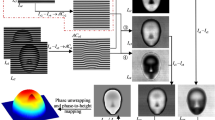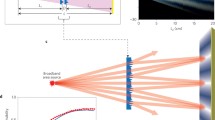Abstract
Two principal problems associated with the practical application of moiré fringes are to obtain sufficient sensitivity for measuring small strains and to develop a simple and inexpensive technique for engraving lines on the surface of a model. This paper deals with simple solutions to both problems. It is shown that the maximum number of fringes that can be observed for a given model is independent of the gratings utilized and depend only on the geometry of the employed optical system. Examples of moiré patterns corresponding to the equivalent of 6000 lines per inch and patterns of the derivatives of the displacements corresponding to the same number of lines illustrate the paper.
Similar content being viewed by others
Abbreviations
- A :
-
light-vector modulus
- D :
-
deformed-grating light-vector complex amplitude; subscript +, positive orders; subscript —, negative orders
- E :
-
light-vector complex amplitude
- f :
-
lens focal distance
- i :
-
imaginary unit
- I(x) :
-
light intensity at the point of coordinatex
- m :
-
lens magnification
- n :
-
diffraction order
- p 1 :
-
undeformed grating pitch
- p 2(x):
-
deformed grating pitch
- r :
-
maximum distance of a point of the model to the optical axis
- R :
-
lens radius
- R :
-
undeformed-grating light-vector complex amplitude; subscript +, positive orders; subscript —, negative orders
- T :
-
film-transmission function
- x, y :
-
coordinates
- α n :
-
nth order diffraction angle
- γ:
-
density vs. exposure tangent
- η:
-
coordinate
- θ(x):
-
gratings phase angles as a function ofx (x axis perpendicular to the grating-lines direction)
- λ:
-
light wavelength
- ν:
-
spatial frequency
References
Guild, J., “The Interference System of Crossed Diffraction Gratings,” Oxford University Press (1956).
Low, I. A. B., “The Moiré Method Using Diffraction Gratings,” SESA Spring Meeting, Detroit, Mich. (May 4–6, 1966).
Sciammarella, C. A., and Lurowitz, N., “Multiplication and Interpolation of Moiré Fringe Orders by Purely Optical Techniques,” Jnl. Appl. Mech.,34 (2) (June 1967).
Post, D., “Analysis of Moiré Fringe Multiplication Phenomena,” Appl. Opt.,6 (11) (November 1967).
Post, D., “New Optical Methods of Moiré Fringe Multiplication,” SESA Annual Meeting, Chicago, Ill. (Oct. 31–Nov. 3, 1967).
Stroke, G. W., and Labeyrie, A., “Two Beam Interferometry by Successive Recording of Intensities in a Single Hologram,” Appl. Phys. Letters,8 (2) (January 1966).
Gabor, D., et al., “Optical Image Synthesis/Complex Amplitude Addition and Subtraction by Holographic Fourier Transform,” Phys. Letters,18 (2) (Aug. 15,1965).
Parks, V. J., and Durelli, A. J., “Moiré Patterns of Partial Derivatives of Displacement Components,” Jnl. Appl. Mech.,33,Series E. (4) (September 1966).
Author information
Authors and Affiliations
Rights and permissions
About this article
Cite this article
Sciammarella, C.A. Moiré-fringe multiplication by means of filtering and a wave-front reconstruction process. Experimental Mechanics 9, 179–185 (1969). https://doi.org/10.1007/BF02326567
Issue Date:
DOI: https://doi.org/10.1007/BF02326567




